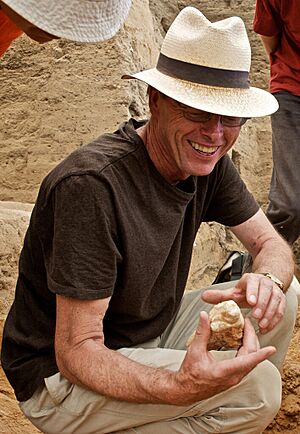Ian Hodder facts for kids
Quick facts for kids
Ian Hodder
|
|
|---|---|

Hodder at Çatalhöyük, 2003
|
|
| Born | 23 November 1948 Bristol, England
|
| Citizenship | British |
| Alma mater | University of London Peterhouse, Cambridge |
| Known for | Pioneering post-processual archaeology |
| Spouse(s) | Francoise Hivernel 1975-1984, Christine Hastorf -2009, Lynn Meskell |
| Scientific career | |
| Fields | Archaeology, Anthropology |
| Institutions | |
Ian Richard Hodder, born on November 23, 1948, in Bristol, England, is a famous British archaeologist. He is known for starting a new way of thinking in archaeology called post-processual archaeology. This idea became popular among his students and in his own work between 1980 and 1990. Since 2002, he has been a professor of anthropology at Stanford University in the United States.
Contents
Early Life and Education
Ian Hodder was born in Bristol, England, on November 23, 1948. His father was Professor Bramwell William "Dick" Hodder. Ian grew up in Singapore and Oxford, England. He went to Magdalen College School, which was a private school for boys in Oxford.
He studied prehistoric archaeology at the Institute of Archaeology at the University of London. He earned his first degree in 1971. Later, he studied at Peterhouse, Cambridge, and received his PhD from the University of Cambridge in 1975. His PhD research was about how to use spatial analysis in archaeology.
Academic Career and Discoveries
Ian Hodder started his teaching career at the University of Leeds in 1974. He taught there until 1977. After that, he went back to the University of Cambridge. He worked there as an assistant lecturer and then as a lecturer in archaeology.
From 1990 to 2000, he was the director of the Cambridge Archaeological Unit. He also became a Fellow at Darwin College, Cambridge. The university made him a Reader in Prehistory in 1990. Then, in 1996, he became a Professor of Archaeology.
Moving to Stanford University
In 1999, Professor Hodder moved to the United States. He joined Stanford University. By 2002, he became the Dunlevie Family Professor there.
Exploring Çatalhöyük
From 1993 to 2018, Professor Hodder led a big international team of archaeologists. They worked on a very old site called Çatalhöyük in central Turkey. This site is about 9,000 years old and comes from the Neolithic period.
The Çatalhöyük Archaeological Project had several goals. These included protecting the site and helping people understand its history. Professor Hodder wanted to try new ways of doing archaeology. For example, he let each archaeologist record their own ideas about the site. In 2012, he made some changes to the team to bring in new ideas. He finished his work at the site in 2018, handing it over to a Turkish team.
Awards and Recognition
In 1996, Ian Hodder was chosen as a Fellow of the British Academy (FBA). This is a very important honor for scholars in the UK. In 2019, he received the Companion of the Order of St Michael and St George (CMG). This award was for his great work in archaeology and for helping improve relations between the UK and Turkey.
Key Publications
Professor Hodder has written many important books and papers. Here are some of them:
- Spatial analysis in archaeology (1976, with C. Orton)
- Symbols in action. Ethnoarchaeological studies of material culture (1982)
- The Present Past. An introduction to anthropology for archaeologists (1982)
- Reading the Past. Current approaches to interpretation in archaeology (1986)
- The Domestication of Europe: Structure and contingency in Neolithic societies (1990)
- The Archaeological Process. An introduction (1999)
- The Leopard's Tale: Revealing the Mysteries of Çatalhöyük (2006)
- Entangled: An Archaeology of the Relationships between Humans and Things (2012)
- Where Are We Heading? The Evolution of Humans and Things (2018)
See also
 In Spanish: Ian Hodder para niños
In Spanish: Ian Hodder para niños

